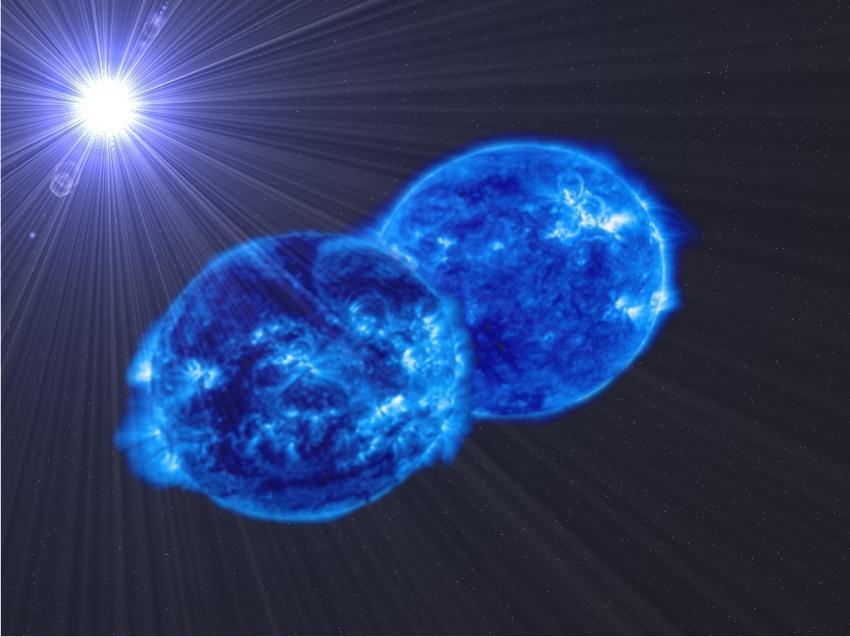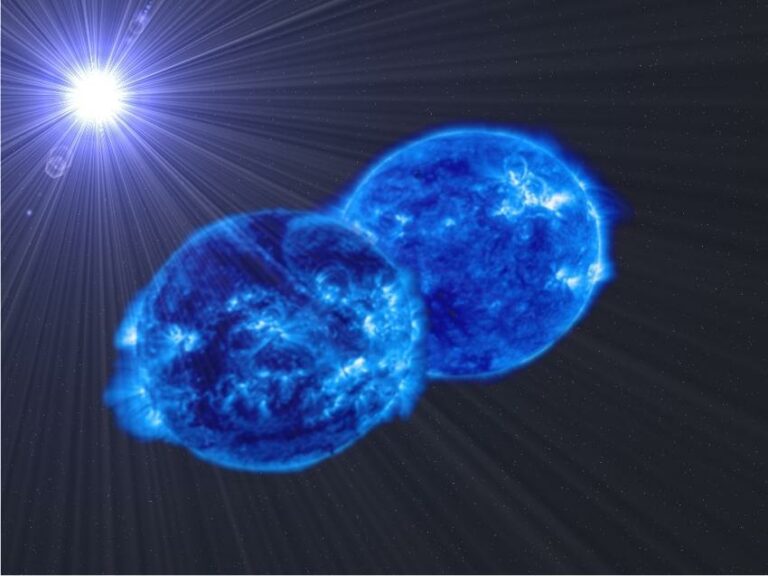Astronomers Witness Two Stars in Imminent Merge, Forming a Supermassive Star
The journal Astronomy & Astrophysics has recently published a study on the binary system known as MY Camelopardalis (MY Cam). This study confirms that the most massive stars in our galaxy are formed through the merging of smaller stars, which aligns with theoretical predictions. MY Cam is an eclipsing binary system, meaning it consists of two stars that undergo eclipses and mutual transits when observed from Earth. The observations for this study were conducted at the Calar Alto Observatory in Almería and involved collaboration between astronomers from the University of Alicante, the Astrobiology Centre of the Spanish National Research Council (CAB-CSIC), the Canaries’ Astrophysics Institute (IAC), and amateur astronomers.
The findings of this study reveal that MY Cam is the most massive binary star ever observed. Its two components are both spectral type O stars, which are blue, very hot, and bright. These stars have masses of 38 and 32 times that of the Sun and are still in the main sequence phase. They are also extremely close to each other, with an orbital period of less than 1.2 days, making it the shortest orbital period among stars of this type. This suggests that the binary system formed with the stars already in close proximity.
Based on these observations, it is expected that the two components of MY Cam will eventually merge into a single object with a mass of over 60 times that of the Sun. This merger is predicted to occur before either of the stars has a chance to evolve significantly. Therefore, these results provide evidence supporting the theoretical models proposing that the most massive stars are formed through the merging of less massive stars.

Massive binary systems
Stars that move independently in the Galaxy, with only their planetary system trailing behind them, are not very common. The majority of stars are actually bound to a companion star or multiple companion stars due to gravity, forming binary or multiple systems. In these systems, all the stars orbit around a common center of mass. Particularly, stars that are much more massive than the Sun tend to always have a companion and have an equivalent mass to many suns. Recent studies suggest that these high-mass stars, which are larger and hotter than the Sun, are often part of systems with at least one other companion of comparable mass.
One notable example is the binary system called MY Camelopardalis (MY Cam), located in the constellation of the Giraffe. MY Cam is the brightest star in the open cluster “Alicante 1,” which was recently identified as a small stellar nursery by researchers at the University of Alicante. Although it has been known for more than fifty years that MY Cam is a high-mass star, it was only ten years ago that it was discovered to be an eclipsing binary system. In an eclipsing binary, one star passes in front of the other during their orbit, causing changes in the system’s brightness as observed from Earth. This characteristic allows us to study the component stars by analyzing the light emitted from them and applying Newton’s law of universal gravitation.
To study MY Cam, professional astrophysicists collected a large number of spectra of the system using the FOCES spectrograph, which was operated for many years in the 2.2 m telescope of Calar Alto Observatory.
The velocities at which stars move in their orbits can be measured using the Doppler Effect. By analyzing the characteristics of the spectra, astrophysicists can also determine important properties of stars such as their surface temperature and size. In order to gather data, amateur astronomers assisted in measuring the changes in light emitted by the system throughout its orbit, known as the light curve. The analysis of this data has revealed that MY Cam is an extraordinary system.
According to Sergio Simon, a researcher at IAC and one of the authors of the article, the light curve indicates that the orbital period of the system is only 1.2 days. Given the large size of the stars, they must be incredibly close to each other in order to complete a full revolution in such a short time. These stars are moving at a speed of over one million km/h, and due to their proximity, the tidal forces between them cause them to rotate on their own axis in just over a day. In comparison, the Sun, which is much smaller, takes 26 days to complete a full rotation. The stars can be likened to giant spinning tops, with every point on their surface moving at a speed of over one million km/h. Despite their immense size, each star has a radius approximately 700 times larger than that of the Earth, yet they rotate at a similar rate.
Furthermore, the stars in this system are incredibly massive, with masses 38 and 32 times that of the Sun. Such massive stars would not easily fit into such a small orbit, leading to the conclusion that they are actually in contact with each other. The outer layers of the stars are mixing, resulting in a common envelope known as a contact binary. MY Cam is one of the most massive contact binaries known, and its components are exceptionally young, as they have not yet begun to evolve.
According to Ignacio Negueruela, a researcher from the University of Alicante, the most intriguing aspect of MY Cam is its potential to confirm certain theories regarding the formation of highly massive stars. The characteristics of the two components of MY Cam indicate that they are exceptionally young stars that formed within the last two million years. This extreme youth suggests that the system likely originated in its current state, although it is possible that the two stars were not initially in contact. As these stars age, they naturally grow in size. Since there is no space between them, this growth will eventually result in the merger of the two stars, forming a colossal star. The specifics of this merger process remain unknown, as it has never been observed before. Some theoretical models propose that the merger occurs rapidly, releasing an immense amount of energy in the form of an explosion. Other studies suggest a less violent process, but nonetheless remarkable. Nevertheless, many astrophysicists believe that the merging of close binary components is likely the most efficient method for generating highly massive stars. MY Cam serves as the first example of a system that could lead to the formation of such objects.
This article is republished from PhysORG under a Creative Commons license. Read the original article.
Do not forget to share your opinion with us to provide you with the best posts !




0 Comments